Six agronomists from across Australia share how their clients are working to protect their crops against stripe rust and other cereal diseases. This is the second article in a series following their journey
Paul Castor, Queensland

Independent agronomist Paul Castor is based in Toowoomba, Queensland. He services growers on the Darling Downs and Western Downs. He is a director of MCA Agronomy, which has offices in Chinchilla and Goondiwindi, Queensland.
From 10 July, we started receiving reports of stripe rust around Tulloona and Croppa Creek in northern New South Wales.
From 20 July, we saw more widespread evidence of seedling stripe rust infections – low-level infestations in resistant to moderately resistant (R-MR) varieties including Sunflex, LRPB Raider and LRPB Lancer. Generally, these have been in NSW locations. In most cases, we are continuing to monitor for signs of adult plant resistance.
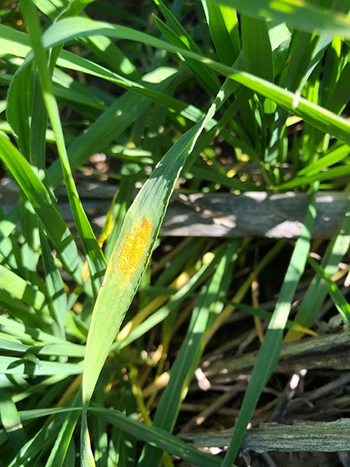 Stripe rust was evident in Coolah (PBR) wheat planted during early May at Croppa Creek, NSW. Photo: MCA Agronomy.
Stripe rust was evident in Coolah (PBR) wheat planted during early May at Croppa Creek, NSW. Photo: MCA Agronomy.
More recently, in northern NSW and southern Queensland, we have found low levels of stripe rust in late-planted moderately resistant to moderately susceptible (MR-MS) varieties before foliar fungicide application at early jointing. Varieties affected included Coolah, Sunmaster and Sunblade CL Plus.
Recently, growers have applied their first foliar fungicide to manage disease-affected wheat. In most cases, these crops will receive a second fungicide application closer to flag leaf emergence.
We have sent samples of stripe-rust-affected crops to the University of Sydney for pathotype analysis.
We have found very low levels of leaf rust in Sunmax (MS) crops, mostly in southern Queensland. The disease appears to be cycling very slowly. We will continue to monitor these crops and apply a possible fungicide to protect the flag leaf if necessary. In warmer environments on early sown crops, the disease has cycled to a reasonable level and these crops were treated early with foliar fungicide.
We have found yellow leaf spot at varying levels in wheat crops planted into 2021 wheat stubble. The worst of these infections is in the odd crop that was sown early into wheat stubble. Given continued regular rain events forecast for coming months, yellow spot will likely need treatment in many wheat-on-wheat paddocks.
We have observed barley leaf rust at higher levels than for many years. Inexpensive fungicides employed for early net blotch management do not appear to be suppressing barley leaf rust activity.
We have also seen net blotch in many barley crops. Growers are managing the pathogen with foliar fungicides.
Powdery mildew in barley is less of an issue in crops, compared to last season.
Rob Holmes, northern New South Wales
 Moree, New South Wales, Rob Holmes, from HMAg, has clients who run irrigated and dryland farming systems incorporating winter and summer cropping.
Moree, New South Wales, Rob Holmes, from HMAg, has clients who run irrigated and dryland farming systems incorporating winter and summer cropping.
Stripe rust is evident across the Moree, NSW, district with MS-rated varieties the most affected.
We have also seen the disease in a couple of MR-MS varieties. This is a concern, and we are double-checking paddock records to ensure the crops affected are MR-MS varieties.
Nearly all stripe-rust-susceptible wheat has been treated with foliar fungicide.
Growers with MS-rated wheat will apply another fungicide at the flag leaf emergence growth stage (GS39) to protect the ‘money leaves’. This should also help manage yellow leaf spot which is prevalent where wheat was planted into last year’s wheat stubble.
A couple of paddocks have been treated with fungicide specifically for yellow leaf spot.
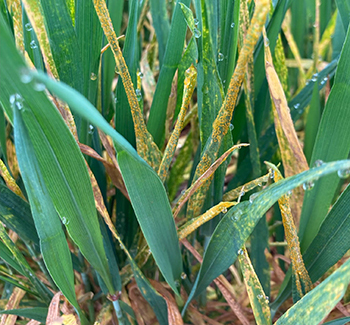 Stripe rust in Coolah (PBR) wheat. Photo: HMAg
Stripe rust in Coolah (PBR) wheat. Photo: HMAg
Also reasonably prevalent is spot form of net blotch in barley.
We have sent about five samples of crops with various disease symptoms, such as stripe rust and oat crown rust, to the University of Sydney for pathotype testing as part of the Australian Cereal Rust Survey.
Emma Robinson, southern NSW
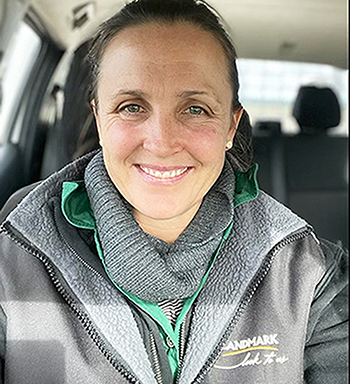 At Temora, in the south-west slopes region of NSW, Nutrien Ag Solutions agronomist Emma Robinson provides advice to mixed farmers growing winter crops.
At Temora, in the south-west slopes region of NSW, Nutrien Ag Solutions agronomist Emma Robinson provides advice to mixed farmers growing winter crops.
During the last week of July, we started seeing seedling stripe rust in Illabo wheat south of Temora, NSW, which was surprising because the crop was sown with fertiliser treated with flutriafol (Impact In-Furrow and Foliar Fungicide).
Illabo wheat growing on heavily waterlogged soil has shown symptoms of stripe rust and Septoria tritici blotch, whereas Illabo wheat grown on better-drained red soil has no symptoms of seedling stripe rust but still plenty of Septoria.
We suspect the fungicide may have washed away from the fertiliser during the wet conditions since sowing, therefore providing less suppression of stripe rust in seedling wheat.
We have sent tissue samples to the University of Sydney’s Cereal Rust Survey for pathotype analysis.
Rust and Septoria have been found in Scepter wheat sown on 5 May. This wheat was sown with flutriafol-treated fertiliser.
We found last year that most Scepter grew through to GS39 (flag emergence) before we saw any stripe rust, but the disease has appeared much earlier this year probably because of the green bridge over summer.
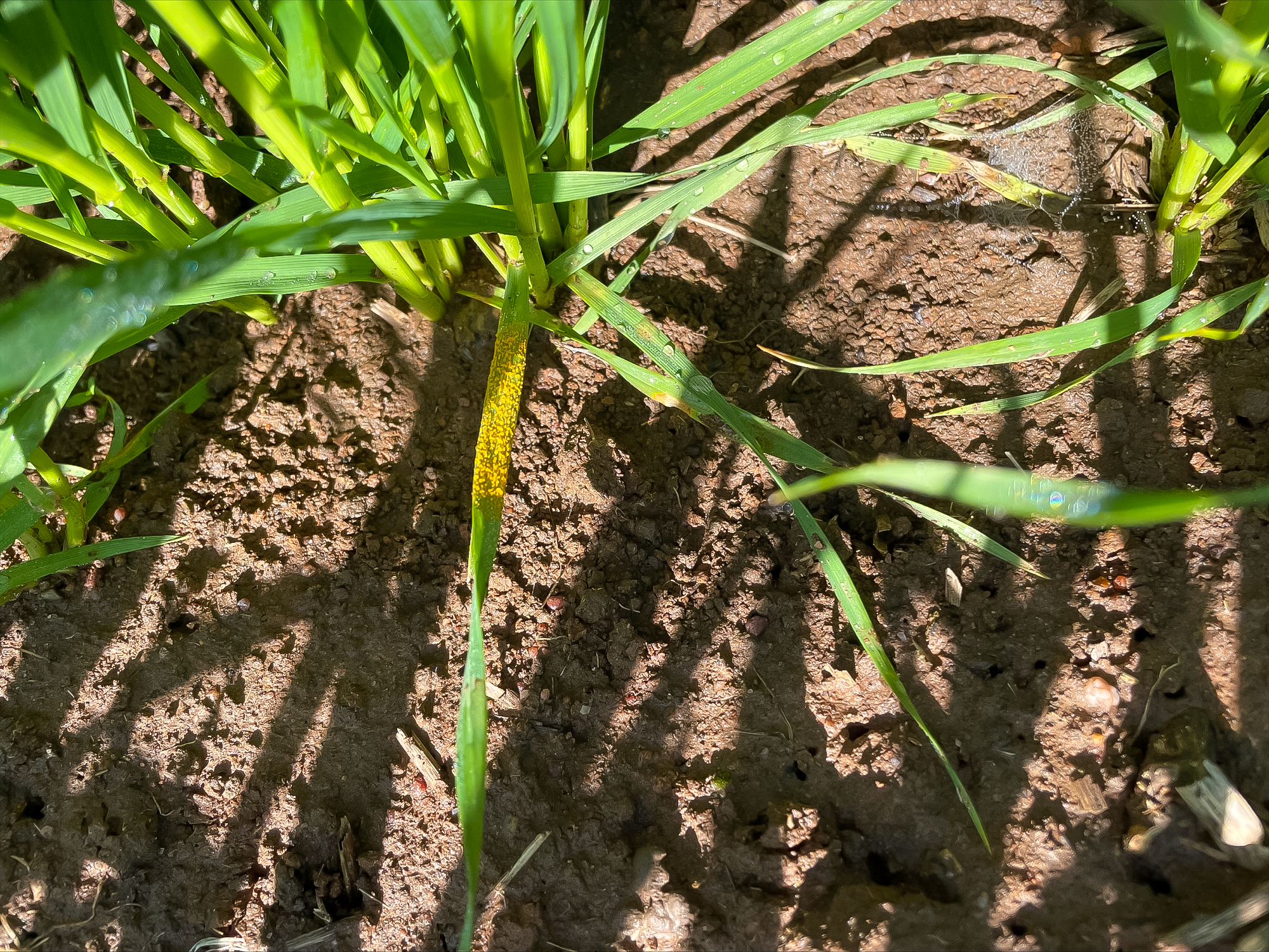
South of Temora, NSW, Nutrien Ag Solutions agronomist Emma Robinson has found stripe rust on Illabo (PBR) wheat. Photo: Emma Robinson
Our plan was to apply a protective rust spray at GS32, but paddock conditions were too wet so that application was delayed. The plan is the same this year, so susceptible wheat varieties when they have reached GS32 will be sprayed with epoxiconazole when paddocks are trafficable. Azoxystrobin (Amistar 250SC) will be applied when the flag leaf has extended at GS39. Paddock trafficability and fungicide timing is a concern after we received 40 to 85 millimetres of rain, with more predicted.
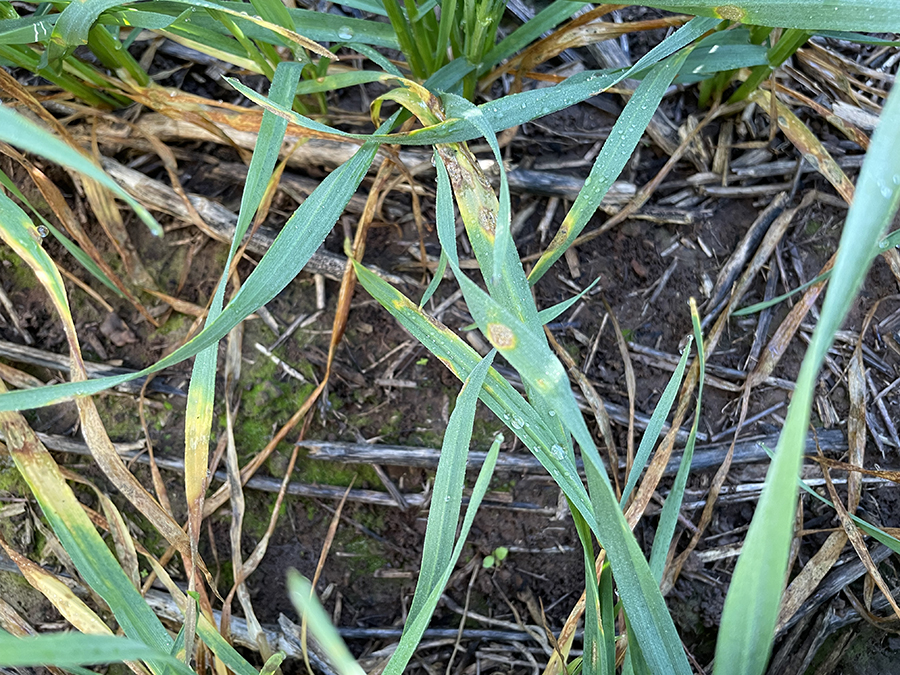
Septoria tritici blotch was also evident on Illabo (PBR) wheat south of Temora, NSW. Photo: Emma Robinson
We will monitor the stripe-rust-affected Illabo for signs of adult plant resistance and start to apply a foliar fungicide at GS31 to manage both the stripe rust and Septoria. If wet seasonal conditions continue, we will also apply a GS39 fungicide to protect the ‘money’ (flag) leaves. Although Illabo has retained good stripe rust resistance, the upper canopy will need to be protected against Septoria and potentially leaf rust.
The main challenge now will be to apply fungicide at the optimal timing because paddocks are wet again and will not be trafficable for weeks.
John Stuchbery, Victoria
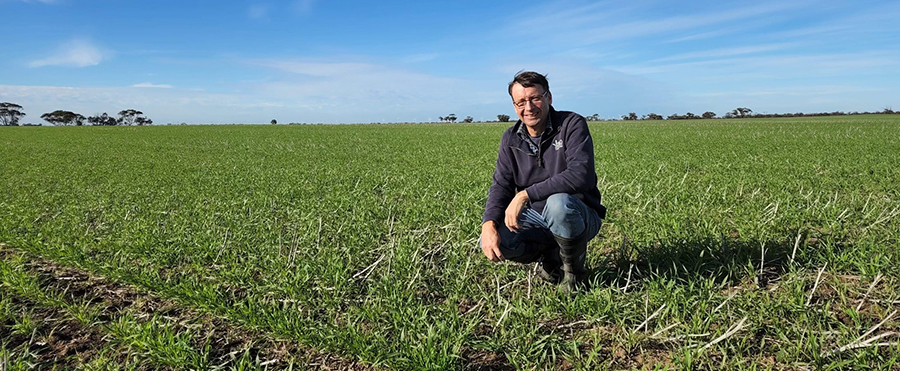
John Stuchbery is an independent agronomist based at Donald, Victoria. He services growers cultivating winter crops in the Wimmera’s medium-rainfall zone.
There have been reports of stripe rust from across the Victorian Wimmera and Mallee over recent weeks. This has been on a range of varieties.
Septoria is widespread in the Wimmera and southern Mallee. We can find it on the lower leaves in almost every crop of Scepter we have looked at. It is likely to spread to upper leaves with future rain events. There have also been some reports of powdery mildew in wheat.

Stripe rust in Scepter (PBR) wheat. Photo: John Stuchbery.
Most of our clients intend to use a preventative strategy with foliar fungicides to control foliar diseases in cereals. The plan is to apply a foliar fungicide at GS31 to 32 and another at GS39 to wheat, depending on seasonal conditions. A single foliar fungicide at GS31 will not protect flag leaves.
In RGT Planet , Spartacus CL and to a lesser extent Maximus barley, we are seeing spot and net forms of net blotch. GS31 fungicide should provide protection until flag leaves emerge at GS37-39 where we can reassess net blotch levels and seasonal conditions.
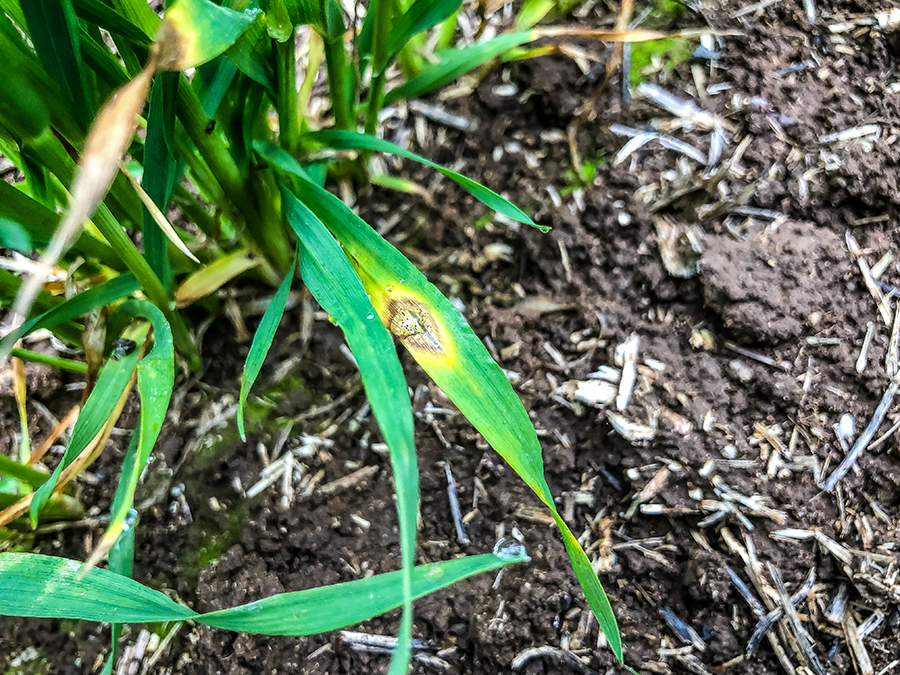
Septoria in Scepter (PBR) wheat. Photo: John Stuchbery.
We are starting to see scald at low levels. The plan is to apply a foliar fungicide at GS31 and another at GS37-39 in barley.
Many crops are at or approaching the correct growth stage for the first foliar fungicide application.
Jeff Braun, South Australia
 Independent agronomist Jeff Braun with son Zac. Jeff consults to growers on South Australia’s Yorke Peninsula, the mid-north and Mallee.
Independent agronomist Jeff Braun with son Zac. Jeff consults to growers on South Australia’s Yorke Peninsula, the mid-north and Mallee.
Stripe rust has been observed in DS Bennett crops in South Australia's northern and southern Mallee.
Generally, growers who applied fungicide at growth stages 30 to 32 have not seen any significant disease pressure to date.
We have seen a small amount of leaf rust in Catapult wheat in the southern Mallee region.
The disease has been evident in early sown crops where volunteers were left uncontrolled after considerable summer rain. These crops were not sown with flutriafol on the fertiliser.
There have also been reports of wheat powdery mildew in the low-rainfall north-eastern Mallee region.
Although this is unprecedented, early sown crops coupled with plenty of early rain produced a well-developed crop canopy allowing the disease to take hold.
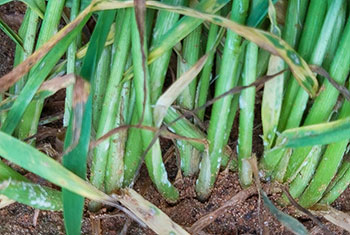 Growers have reported wheat powdery mildew in the low-rainfall north-eastern Mallee region.
Growers have reported wheat powdery mildew in the low-rainfall north-eastern Mallee region.
Our clients applied tebuconazole at the maximum label rate to suppress the disease and prevent pathogen movement into the upper canopy.
In barley, we have seen both spot form of net blotch and net form of net blotch, mainly in the warmer coastal areas.
However, at this stage, conditions have been too cool for the disease to progress significantly.
Most growers who have seen disease symptoms applied a foliar fungicide at early stem elongation.
Trent Butcher, Western Australia
 ConsultAg research agronomist Trent Butcher is based at Narrogin, Western Australia. He provides advice to mixed farmers and continuous croppers from west of Narrogin to Lake King in the eastern grain belt.
ConsultAg research agronomist Trent Butcher is based at Narrogin, Western Australia. He provides advice to mixed farmers and continuous croppers from west of Narrogin to Lake King in the eastern grain belt.
We have not seen any stripe rust in wheat in Western Australia. Oats are also free from rust.
All crops are looking good after rainfall during early August.
We have seen Septoria in oats and spot form of net blotch in barley. We do not tend to see rust in barley.
In the northern grain belt, there have been widespread reports of powdery mildew affecting wheat and barley. The central and southern grain belt has had sporadic outbreaks of the disease.
A shift in virulence to the MILa resistance gene means varieties such as Rosalind barley are showing susceptibility and need proactive management for barley powdery mildew.
In general, disease pathotypes have not been as active in cereal crops grown this year compared to 2021.
We saw plenty of fungal activity early in this year’s growing season, but cool conditions slowed disease development and symptoms in crops until rain fell during early August.
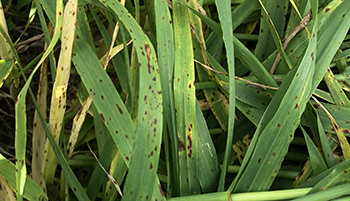 Spot form of net blotch in Scope (PBR) barley. Photo: Trent Butcher
Spot form of net blotch in Scope (PBR) barley. Photo: Trent Butcher
We expect to see more disease in cereal crops that have not had a fungicide treatment at the flag minus one growth stage, especially with rising temperatures and continued rain.
In the next week, barley growers will be applying their final fungicide treatments. Early sown crops have already been treated to protect the money leaves.

























































